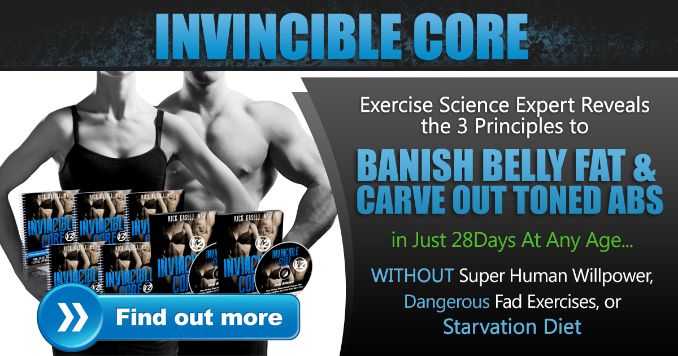Core strength is at the heart of almost everything I do, whether it’s lifting something heavy, running, or just trying to maintain good posture throughout the day. That’s why I’ve found incorporating core fusion into my routine has made such a difference. It’s helped me build strength, improve my balance, and even lowered my risk of injury.
For me, core fusion is more than just a workout—it’s a blend of isometric holds and dynamic movements that really target every muscle in my core. I love how it challenges me in ways other exercises don’t, pushing me to engage muscles I didn’t even realize were part of my core. It’s become one of the most effective ways for me to build a solid foundation for everything else, whether it’s during my workouts or just handling everyday tasks.
What Is Core Fusion?
Core Fusion is a unique blend of isometric exercises (which involve holding static positions) and dynamic movements (which require controlled movement). The goal is to engage all the muscles that support your spine, including your abs, obliques, and lower back muscles, in a balanced way.
So, what sets it apart? Core fusion workouts create functional core strength [1] by combining different exercise types that stabilize the body and assist with dynamic movements like bending, twisting, and lifting. Whether you’re an athlete or want to improve your everyday movement, this training method works on core strength and stability simultaneously.
How Core Fusion Works
Core Fusion is a hybrid workout approach combining isometric static holds (like planks) with dynamic core movements (such as crunches) to engage and strengthen your core in one efficient session.
Here’s how it works:
1. Isometric Exercises For Core Stability
- Involves holding a static position without movement (e.g., planks).
- Activates deep core muscles that support your spine.
Helps improve posture and prevent injuries by engaging multiple muscle groups like shoulders, glutes, and lower back.
2. Dynamic Movements For Core Strength And Mobility
- Involves movement-based exercises (e.g., crunches, mountain climbers, Russian twists).
- Targets the larger, superficial muscles that contribute to strength and tone.
- Enhances both strength and mobility.
By integrating isometric holds and dynamic exercises, core fusion offers a balanced workout that builds core strength and improves functional movement. This combination supports daily activities like lifting, twisting, and maintaining proper posture.
3. Core Fusion is Accessible and Efficient
- Uses bodyweight resistance, so no special equipment is required.
- It can be performed anywhere, including at home or while traveling.
- Sessions typically last under 30 minutes, making it easy to fit into your schedule.
- Suitable for all fitness levels, with room for progression as strength improves.
Incorporating core fusion 2–3 times a week can help you build a stronger, more stable core, positively impacting your overall fitness and daily life.
The Benefits Of Core Fusion Workouts
A regular core fusion workout offers a wide range of benefits for your overall fitness and daily life:
Improves Core Stability: Core fusion strengthens the muscles that stabilize your spine, leading to better posture and balance. This stability helps you move more efficiently and reduces the strain on other muscle groups.
Injury Prevention: By targeting deep core muscles, core fusion helps protect your spine and lower back, reducing the risk of common injuries and preventing back pain associated with weak core muscles.
Enhanced Athletic Performance: A strong core enhances your ability to lift heavier, run faster, and perform better in sports and physical activities. Core fusion boosts your strength, power, and endurance. Dr. Jordan Metzl, a sports medicine physician, underscores that core strength is foundational for athletic movements like running and lifting. He recommends incorporating isometric holds and dynamic exercises—similar to those in Core Fusion—to improve stability and reduce the risk of sports-related injuries.
At-home Friendly: Core fusion is perfect for at-home workouts, requiring little to no equipment. You can perform these exercises anywhere, making it convenient and accessible for anyone, even with a busy schedule.
By incorporating core fusion into your routine, you’ll build strength and improve functional movement, leading to better physical performance and daily comfort.
3 Powerful Moves For Core Strength
These three exercises form the backbone of a strong core fusion workout. Together, they target every area of your core, improving strength and stability.
1. Forearm Plank

Begin in a 4-point position with your knees beneath your hips and your hands beneath your shoulders.
Step back with both feet to move into a straight-arm plank position, maintaining good alignment with your head, shoulders, hips, and toes.
Engage your core and lower forearms down to the floor to lower yourself into a forearm plank position.
Hold the position for several deep belly breaths, in through your nose and out through your mouth.
2. Double Leg Raise

- Lie on your back on the floor with your legs extended straight.
- Place both hands behind your head, with elbows bent and pointing outward.
- Engage your core, then lift and straighten both legs to a 30-degree angle.
- Hold this position for several deep belly breaths through your nose and mouth.
- Relax and lower your legs to return to the starting position.
- Repeat the movement as needed.
3. Low Lunge
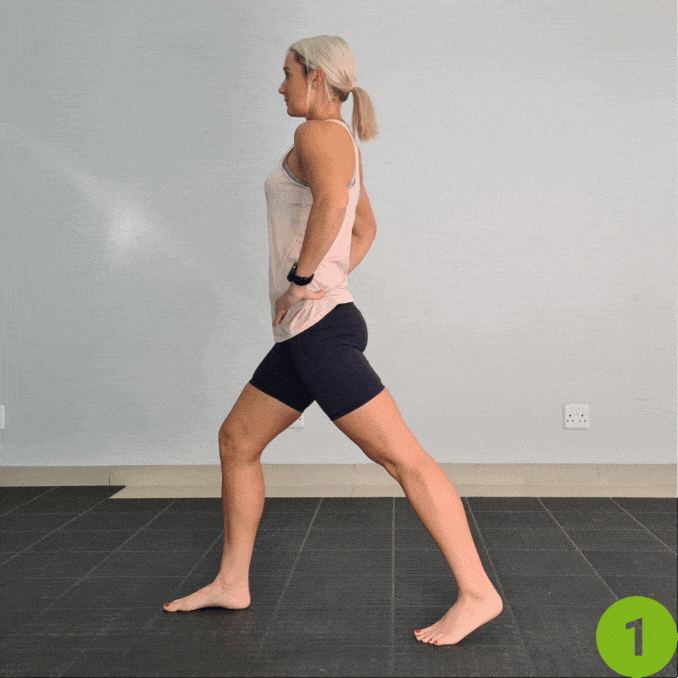
Begin in an upright standing position with your feet hip-width apart, maintaining good alignment with your head, shoulders, and hips.
Engage your core.
Then, take a big step back with one foot and lower your back knee towards the floor, keeping your toes straight ahead.
Hold the positon for a couple of seconds, then raise back up to return to the starting position.
Repeat the movement on the opposite side.
Sculpting Your Core: 3 More Dynamic Core Fusion Moves
After building a solid foundation with the first set of exercises, these more dynamic movements help further define and sculpt your core.
1. Dead Bugs
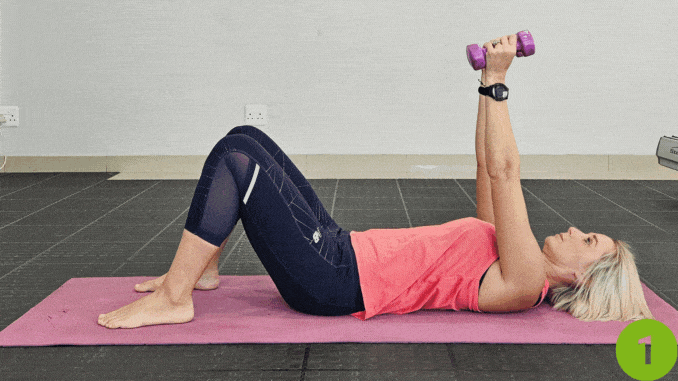
For this exercise, you may utilize a dumbbell.
Lie on the floor with your knees bent and your feet flat.
Hold a dumbbell in each hand while relaxing your upper body.
Raise your knees and arms to 90-degree angles.
Tilt and squeeze your pelvic muscles, then extend your arms overhead while lowering your opposite leg to parallel the floor.
Return to the starting position and repeat the movement on the opposite side.
Start with 1 set of 5 repetitions on each side.
2. Ball Woodchop
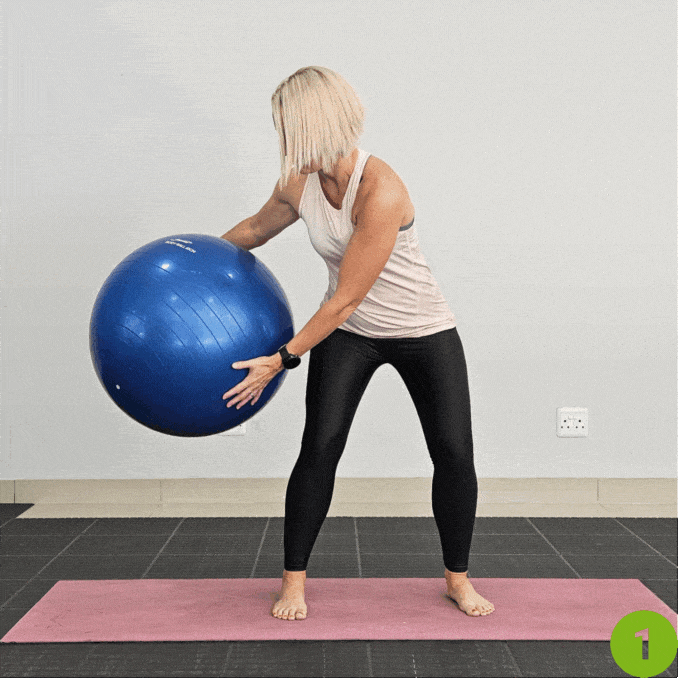
For this exercise, you may utilize a stability ball.
Begin in an upright standing position with your feet wider than your shoulder width apart, maintaining a good alignment with your head, shoulders, and hips.
Hold the ball with both hands.
Engage your core and extend your arms over one shoulder.
Lower the ball down diagonally to your opposite foot, bending your knees to move into a squat position.
Then, return to the starting position and repeat the movement.
Start with 1 set of 5 repetitions on each side.
3. Bird Dog
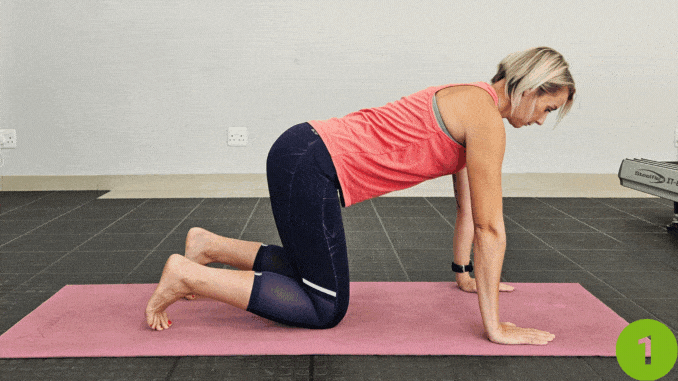
Begin in a 4-point position on the floor, with your hands underneath your shoulders and your knees underneath your hips.
Contract your abdominal area.
Inhale and lift your one arm to be in line with your shoulder as you extend your opposite leg behind your body.
Keep your hips and shoulders parallel to the floor.
Exhale to return to the center, bringing your elbow towards your bent knee and rounding out your lower back as you slowly drop your head down.
Relax and repeat the movement on the opposite side, with 10 repetitions on each side.
Tips For A Stronger Core With Core Fusion
Prioritize Form: Proper form is key to preventing injury and maximizing results. Keep your core engaged, and avoid arching your back during exercises.
Control Your Breathing: Inhale during the easier part of the movement and exhale during the exertion to maintain core stability [2].
Engage All Core Muscles: Remember, your core includes your obliques, lower back, and glutes. Focus on activating all areas for balanced strength.
Progress Slowly: Start with beginner variations, then gradually increase reps or intensity as your strength improves.
Balance with Full-Body Workouts: Combine Core Fusion with cardio or strength training for overall fitness and better core definition. Dr. Dennis T. Villareal, a professor at Baylor College of Medicine, emphasizes the importance of resistance training for building muscle and enhancing mobility, both of which are crucial for developing core strength.
Be Consistent: Aim for 2-3 weekly sessions to build strength and see long-term benefits.
Listen to Your Body: If you experience pain, especially in your lower back, adjust your form or take a break to prevent injury.
How To Incorporate Core Fusion Into Your Routine
To get the most out of core fusion, include these workouts in your routine 2 to 3 times a week. This frequency allows your muscles to recover while providing consistent strength-building engagement. Core fusion workouts are highly versatile and can be easily adapted to fit your lifestyle, whether at home, in the gym, or on the go.
At Home: Since core fusion primarily uses bodyweight exercises, you don’t need any special equipment. You can complete a session in your living room or any space allowing movement.
As per Dr. Allan Mandell, even a simple seated core workout can be efficient when approached properly, “Seated core exercises, along with a good diet, you can tone up your stomach nice and tight—your body will love you.
At the Gym: If you prefer working out at a gym, core fusion can complement other strength or cardio exercises. You can also use light weights or resistance bands to add variety and challenge to your routine.
While Traveling: The portability of core fusion makes it perfect for travel. You can perform these exercises in a hotel room, park, or even an airport lounge with minimal space.
Regardless of where you do your workout, the key to success is consistency. By committing to regular sessions, you will see improvements in core strength, stability, and overall fitness. To ensure steady progress, focus on form and gradually increase the intensity of your exercises as you grow stronger.
Incorporating core fusion regularly will enhance your workout routine and provide long-term benefits, from better posture to reduced risk of injury.
Conclusion
Core fusion offers a holistic approach to building core strength by combining isometric and dynamic exercises to stabilize and strengthen your core. Core Fusion is a powerful tool for improving your posture, relieving back pain, or enhancing your athletic performance.
If you’re ready to unlock your full potential, try incorporating these exercises into your routine. The Invincible Core program is designed to help you build a solid foundation, whether a beginner or advanced. Start building your stronger, healthier core today!


